Site map for the First Pan-Arab Games, held in Alexandria in 1953. Assisting spectators in making their way around the Olympic site, the map details stadiums, sports clubs and racing grounds, along with schools, museums, and the British Consulate. The schedule on the reverse indicates buses and trams calling at the various competition venues, not failing to mention the events and sports to be witnessed there, including athletics, weightlifting, football, swimming, basketball, boxing, wrestling, and shooting, as well as the opening and closing ceremonies.
The Arab Games, formerly called the Pan-Arab Games, are a regional multi-sport event held between nations from the Arab world. They are organized by the Union of Arab National Olympic Committees and intended to be held every four years, though political turmoil as well as financial difficulties have made the event an unstable one.
A few minor tears. Generally well preserved.
First separate edition: legal treatise on the international status of Kuwait, Bahrain and Qatar, with particular respect to the British protectorate. Prepared by Issam Abdel Rahman Azzam, an expert on international and Middle Eastern law, drawing on his own master thesis of the same title.
The paper explains the constitutional system and structure of government of the three states, elaborates on matters of extraterritorial jurisdiction, and stresses the necessity of clear national boundaries, particularly since "oil discoveries and exploitations converted the unclaimed desert territories into valuable assets and the problem has taken on the form of territorial disputes between most of the states on the Persian Gulf" (p. 34).
Offprint from the "Revue Egyptienne de Droit International", no. 15. Slightly toned, otherwise very well preserved.
The last official report report on Mandate Palestine by the British Colonial Office, submitted annually to the League of Nations Mandates Commission, detailing the Arab Revolt of 1938. This final report was issued in the midst of the 1936-38 revolt against British colonial rule, and includes the Colonial Office's traditionally detailed records on the local economy, politics, judicial system, public health, and religion. Much additional attention is given, however, to British and League promotion of Zionist interests, and to a summary of the events and reprisals of the Revolt.
After the collapse of the Ottoman Empire following the close of the First World War, Ottoman territories were distributed as spoils of war amongst the victors (in practice, largely Britain and France). Britain's colonial office ruled the Mandate of Palestine in the name of the League of Nations, to whom it was required to submit this annual report. The first full report was made in 1924 and continued annually until 1938.
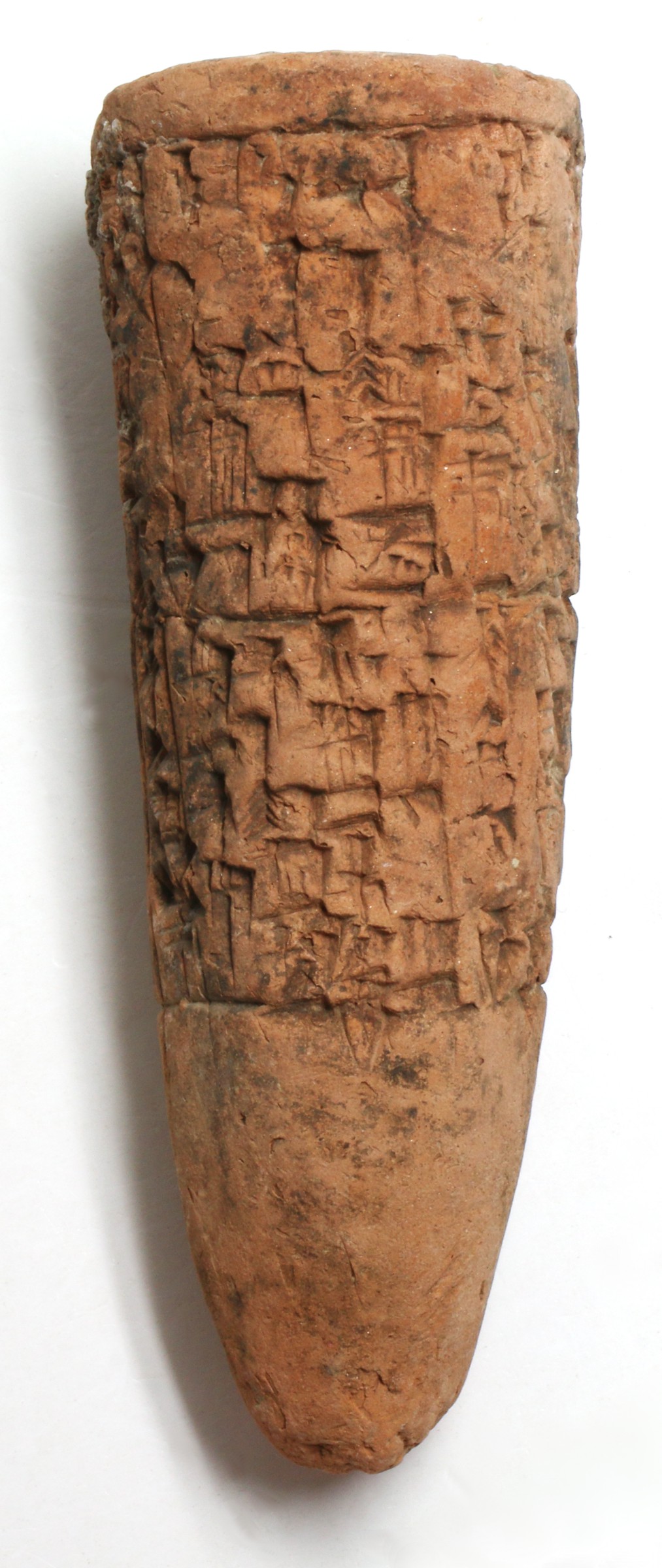
Foundation cone of light reddish clay with a flat base on the broadside and a rounded tip on the other side. The 18-line inscription, covering around two thirds of the cone, originates from Ishme-Dagan, the fourth king of the First Dynasty of Isin. He ruled over southern Mesopotamia. This foundation cone certifies that under his reign the city walls of Isin were fortified. The translation of the inscription reads: "When Ishme-Dagan, the mighty, king of the four world regions, abolished the taxes of Nippur, the city beloved of Enlil, and excused its men from military service, he built the great ramparts of Isin, and the name of that wall is Ishme-Dagan".
Used by Sumerians and other Mesopotamian cultures beginning in the third millennium BCE, foundation cones, also referred to as dedication or foundation pegs or nails, were cone-shaped nails made of clay, inscribed with cuneiform, baked, and stuck into the mudbrick walls to serve as evidence that the temple or building was the divine property of the god to whom it was dedicated.
Rare topographical map of Iran during the Pahlavi era, in Farsi language. Indicates major cities including Tehran, Isfahan, Shiraz, Kermanshah, and Mashhdad. Among the other most notable features appear the Zagros and Alborz mountains, the Khuzestan Plain, and lakes Namak and Urmia, along with roads, railroads, bridge tunnels, rivers, and marshes. The map further includes parts of Iraq, Turkey, the Caucasus, the Soviet Union, Afghanistan and Pakistan, Kuwait, Bahrain, Qatar, and the Emirates with Dubai and Sharjah labelled.
Several tears, some repaired with archival tape.
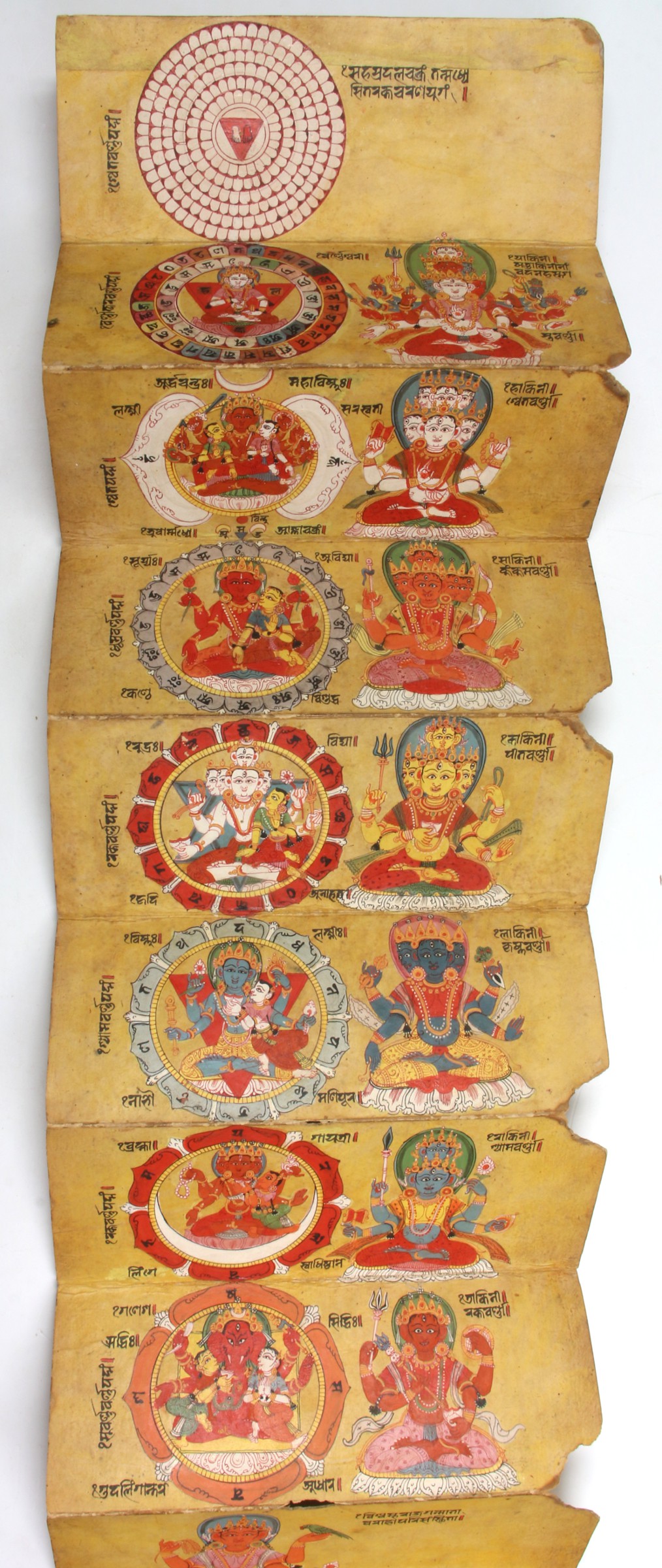
With eight leaves of hand-painted illustrations and several large diagrams: a Nepalese Sanskrit manuscript, elaborately decorated. The eight leaves of paintings show a procession of gods and goddesses in sequence, each accompanied by a dedicated shloka (a form of religious verse). Some of these deities take the form of animals: one is Varah, the boar that serves as an avatar of Vishnu, another Shesh Naag, the god snake, and a turtle and frog. Alongside these are the goddesses Jaganmata (literally "mother of the world," referring to Lakshmi, and identifiable by the two flowers she holds) and Gayatri. The distinctive elephant-headed Ganpati (Ganesha), too, appears, flanked by his consorts Riddhi and Siddhi. Each is elaborately painted and decorated, and due to the nature of the concertina book, can be viewed in sequence or unfolded to be viewed all at once. Within the text itself are elaborate geometrical diagrams, similar to astrological designs.

Complimentary branded calendar for the year 1969, handed out to General Petroleum employees. A table of selling prices for petrol per litre at service and supply stations in Egypt is on the reverse.
Slightly creased and spotted. Enclosed is a print company logo on a small rectangular sheet (unevenly cut, ca. 97 x 104 mm).
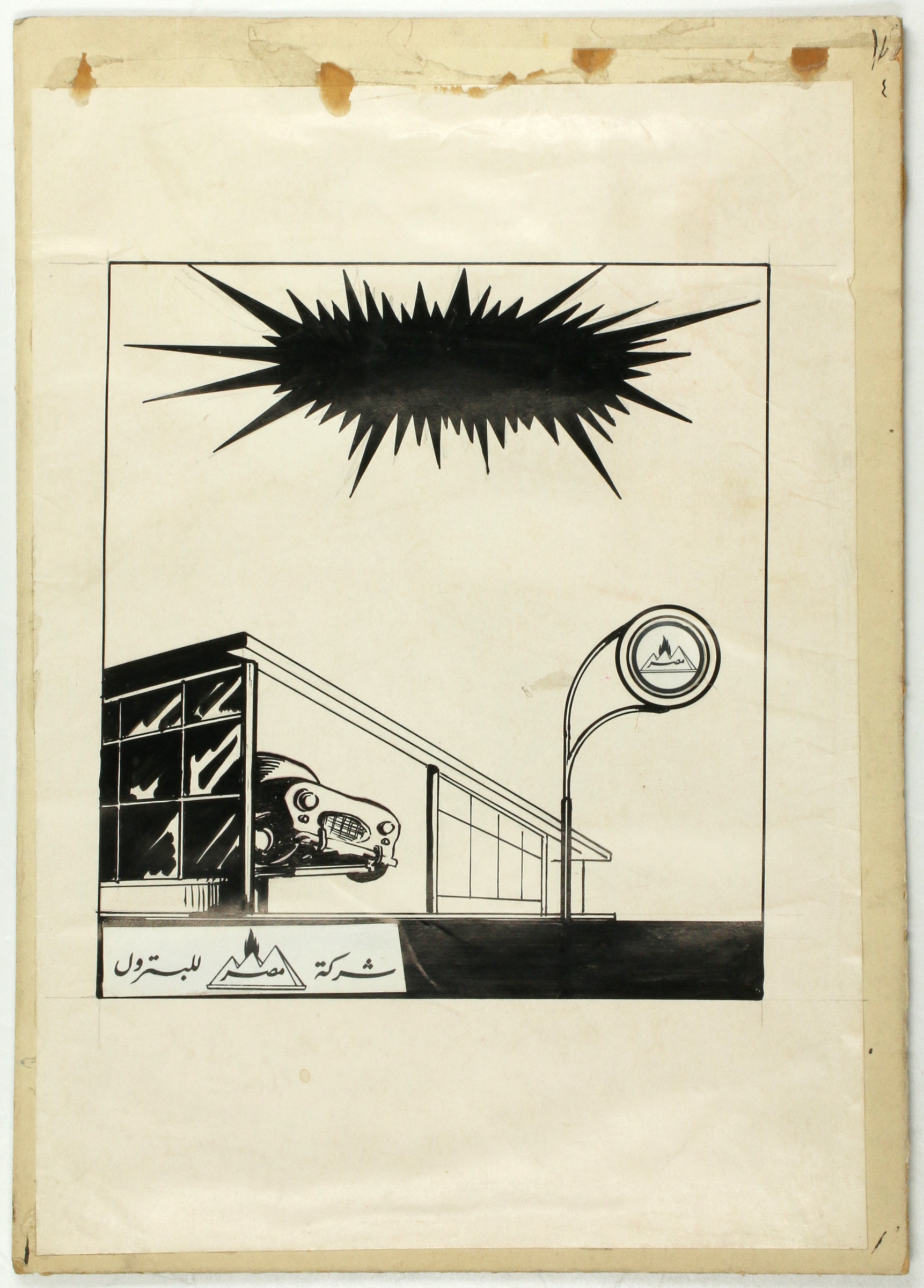
Unique drawing of a General Petroleum service station, featuring a car on a hydraulic lift and a coporate signpost on the street. With 2 company logos cut out from a magazine and pasted to the signpost and to the lower left corner of the drawing. A jagged element resembling an oil blot in the otherwise blank part above the service station was presumably intended for a caption but lacks any lettering, suggesting that the drawing was left unfinished.
A little creased. Backing cardboard somewhat worn with fragments of handwritten Arabic script in blue and green on the reverse.

Educational brochure on company endeavours, describing the leading role of General Petroleum as supplier of fuels for heavy industry and agriculture, as well as various kinds of transportation and their clientele, including international shipping lines frequenting the ports of Egypt. In addition, the company produces a variety of petrochemicals, including pesticides, insecticides, and detergents for both agricultural and domestic use.
Very well preserved.
First edition of Fiamelli's work on military fortifications, extensively illustrated with woodcut diagrams. A Florentine mathematician and engineer who worked for the Duke of Parma in the Low Countries, Giovanni Fiammelli (1565-1614) was particularly interested not only in the engineering of these monumental Renaissance defenses, but also in debating the pros and cons of military fortifications in different defensive positions and battle plans. This stemmed in part from an older debate stirred up by the likes of Niccolò Machiavelli, whose writings a generation earlier discussed the varying usefulness of fortifications for a ruler. Machiavelli had suggested that extensive fortifications were useful only when the ruler of an Italian principality feared uprisings from their own people, but were not a particular advantage for foreign invasions; he stressed fortifications around cities rather than personal castles, and winning the loyalty (or at least lack of hatred) of the populace.
In "Il principe difeso", Fiammelli uses his greater engineering knowledge to design and examine the strengths and weaknesses of fortifications. He holds that good ones are useful, but that they have to be used competently in order to be effective. This is one of several military works that Fiammelli wrote while resident in Rome at the end of his life.
Original press photograph of the Palestinian delegation to the 1939 London Conference, meeting with Prime Minister Chamberlain and other British officials in St. James's Palace. The conference was called by the British Government to plan the future governance of Palestine and an end of the Mandate. It took place between 7 February and 17 March 1939.
The photograph shows the Palestinian delegates sitting in the foreground, including Jamal Al-Husseini, Amim Tamimi, Fuad Saba, Yaqub Al-Ghussein, Musa Alami, Awni Abdul Hadi, George Antonious, and Alfred Roch. Facing are the British, with Neville Chamberlain presiding. To his right is Lord Halifax, and to his left, Colonial Secretary Malcolm MacDonald. Famously, MacDonald held a series of separate meetings with the Palestinian and Zionist delegations, because the Palestinian delegation refused to sit in the same room as the Zionists, a circumstance also indicated by the caption on the photograph: "Meetings have to be in two sections since Arabs refuse to meet in same room with their Jewish rivals".
Coming to an end after five and a half weeks, the conference remained inconclusive, the British announcing proposals which were later published as the 1939 White Paper.
Corners slightly creased; one small tear to lower margin, not affecting image.
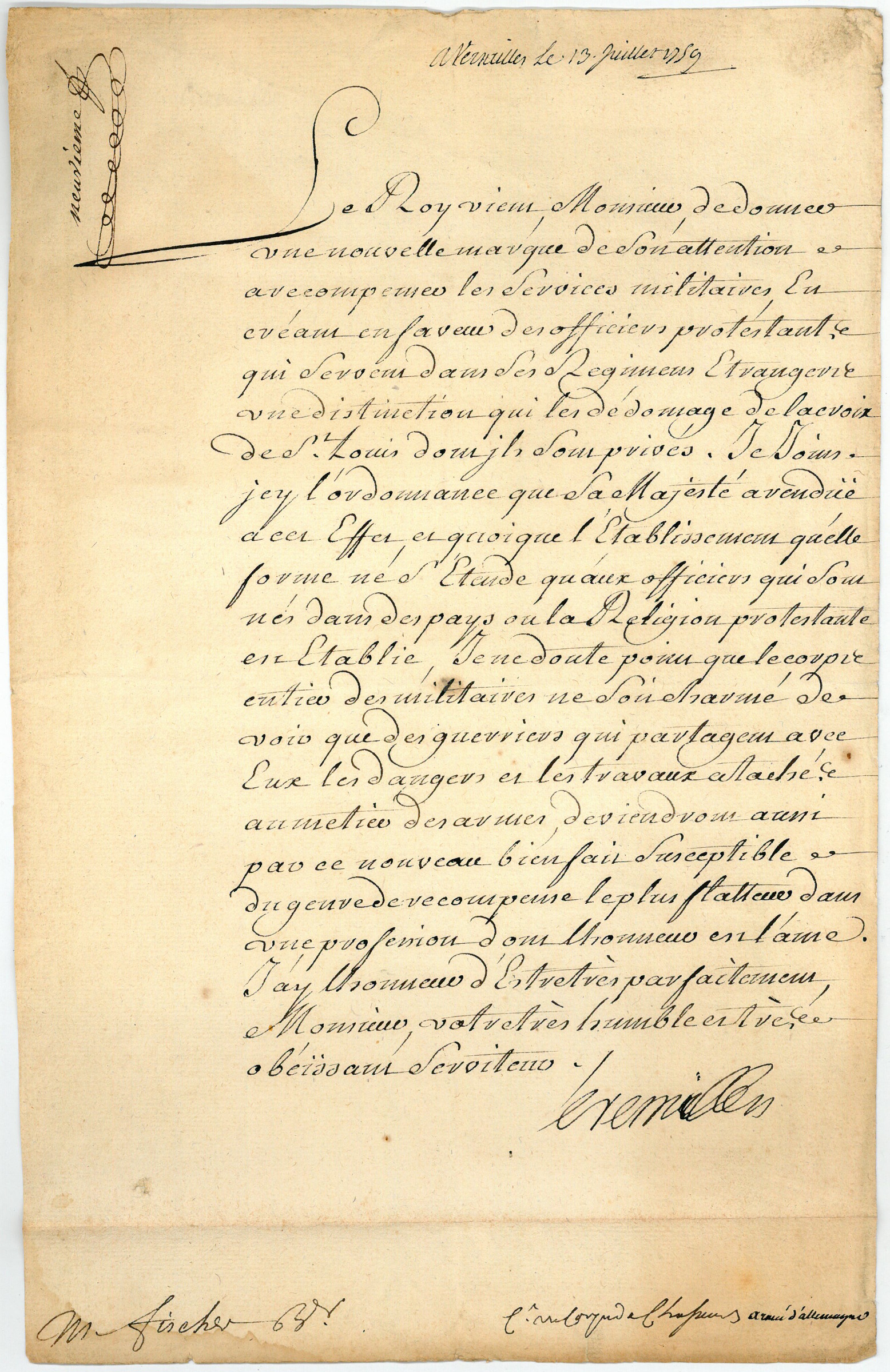
Highly interesting letter concerning the establishment of the Institution du Mérite militaire, a French military order that was created on 10 March 1759 by King Louis XV for foreign-born, non-Catholic military officers in French service. The letter is addressed to Johann Christian Fischer (1713-62), a German officer who led mostly German mercenaries in French service, so-called Volontaires Étrangers, since the 1742 Siege of Prague during the War of the Austrian Succession. In 1743 Fischer was authorized to raise a company of light cavalry and infantry that came to be known as the "Chasseurs de Fischer". The company fought in the War of the Austrian Succession and the Seven Years' War and was dissolved in 1776, being largely incorporated to the hussar regiment of Louis Gabriel Marquis de Conflans.
Boyer de Cremilles, who served in the war ministry under Charles Louis Auguste Fouquet de Belle-Isle, was delighted to inform Fischer of the new Order of Merit and originally attached a copy of the royal ordinance issued for its creation. As Protestants were excluded from the Order of Saint Louis, this new honour was supposed to offer them "compensation", and although it was reserved for foreigners in French service, he was convinced that the "entire military corps will be delighted" and that it would bolster general morale.
Minor browning.
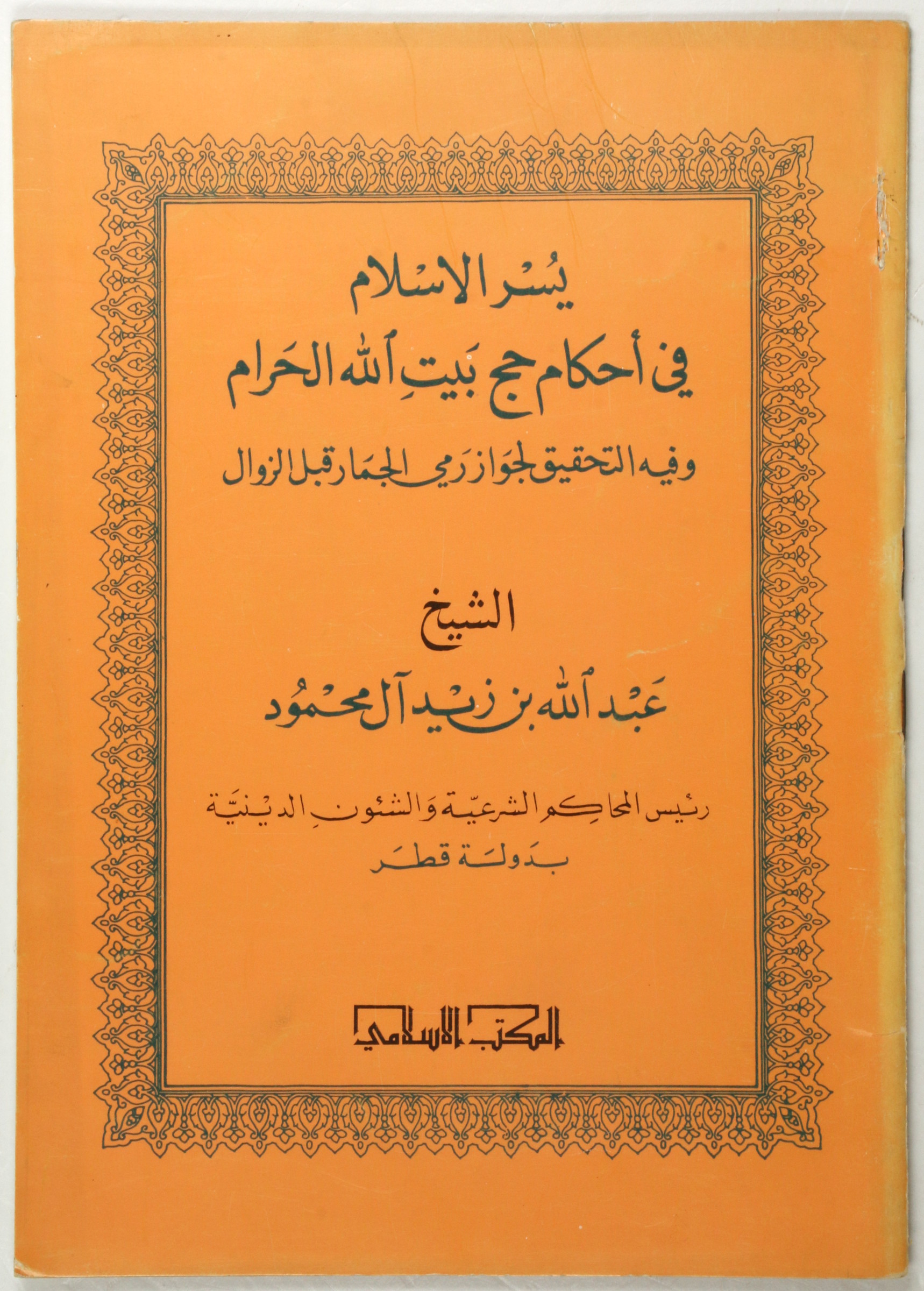
Rare publication by Sheikh Abdullah bin Zaid al Mahmoud of Qatar: essentially, an official guidebook comprising the basic rules of Hajj, including provisions for the stoning ritual as well as a permission for menstruating women to circumambulate the Kaaba.
One staple removed. In very good condition.
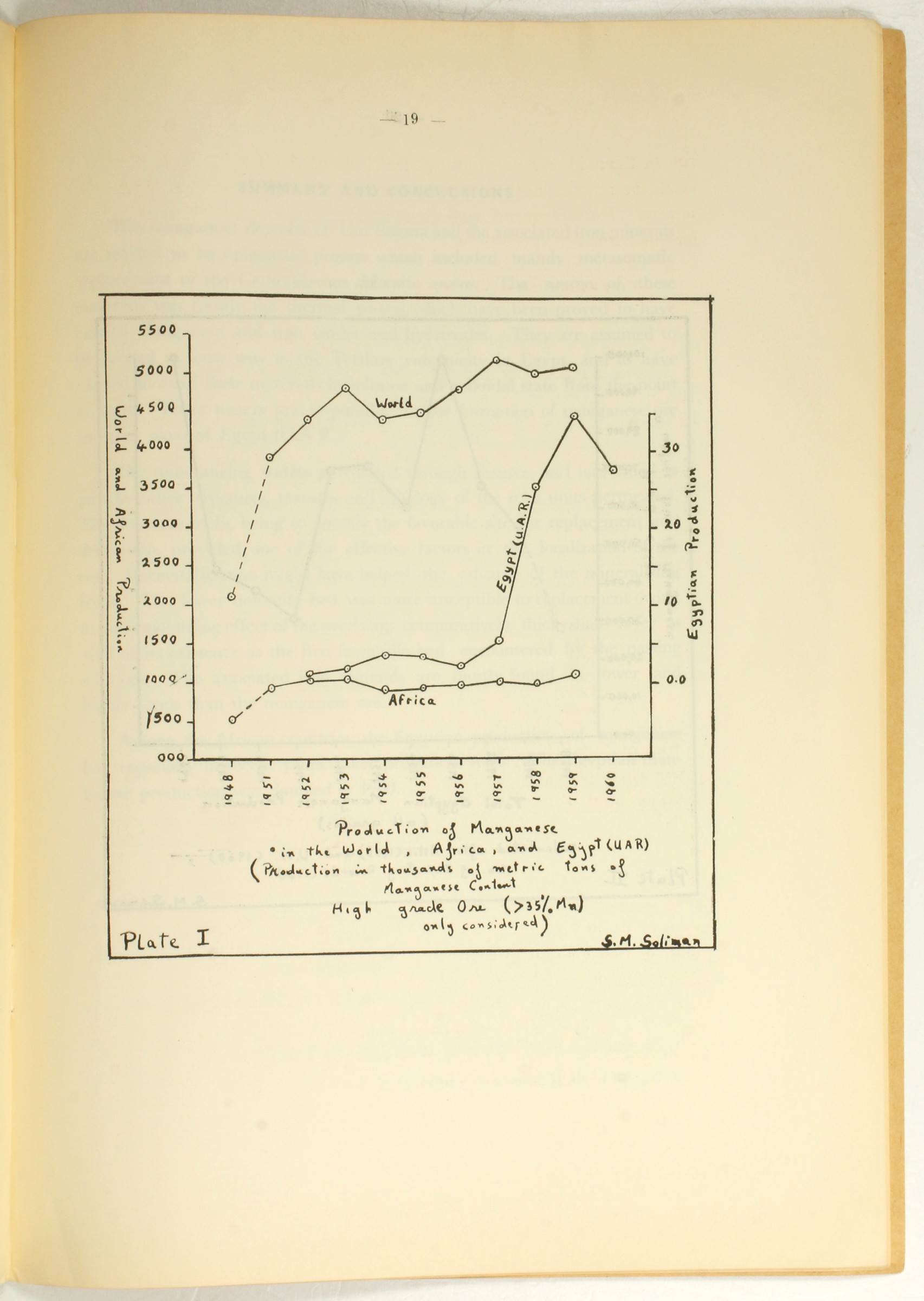
Scarce geological paper on manganese ores prepared by Dr. Soliman Mahmoud Soliman, professor of Geology at Ain Shams University in Cairo, who published prolifically on topics related to oil prospecting. Presented at the First Congress of Iron and Steel held from 6 to 9 November 1961. The paper investigates the evolution and structure of manganese ore deposits in Um Bogma on the Sinai Peninsula and the Egyptian production of manganese in general, arguing that the latter "has taken wide steps in recent years".
In excellent condition. Only a single library copy traceable worldwide, held at Yale University.
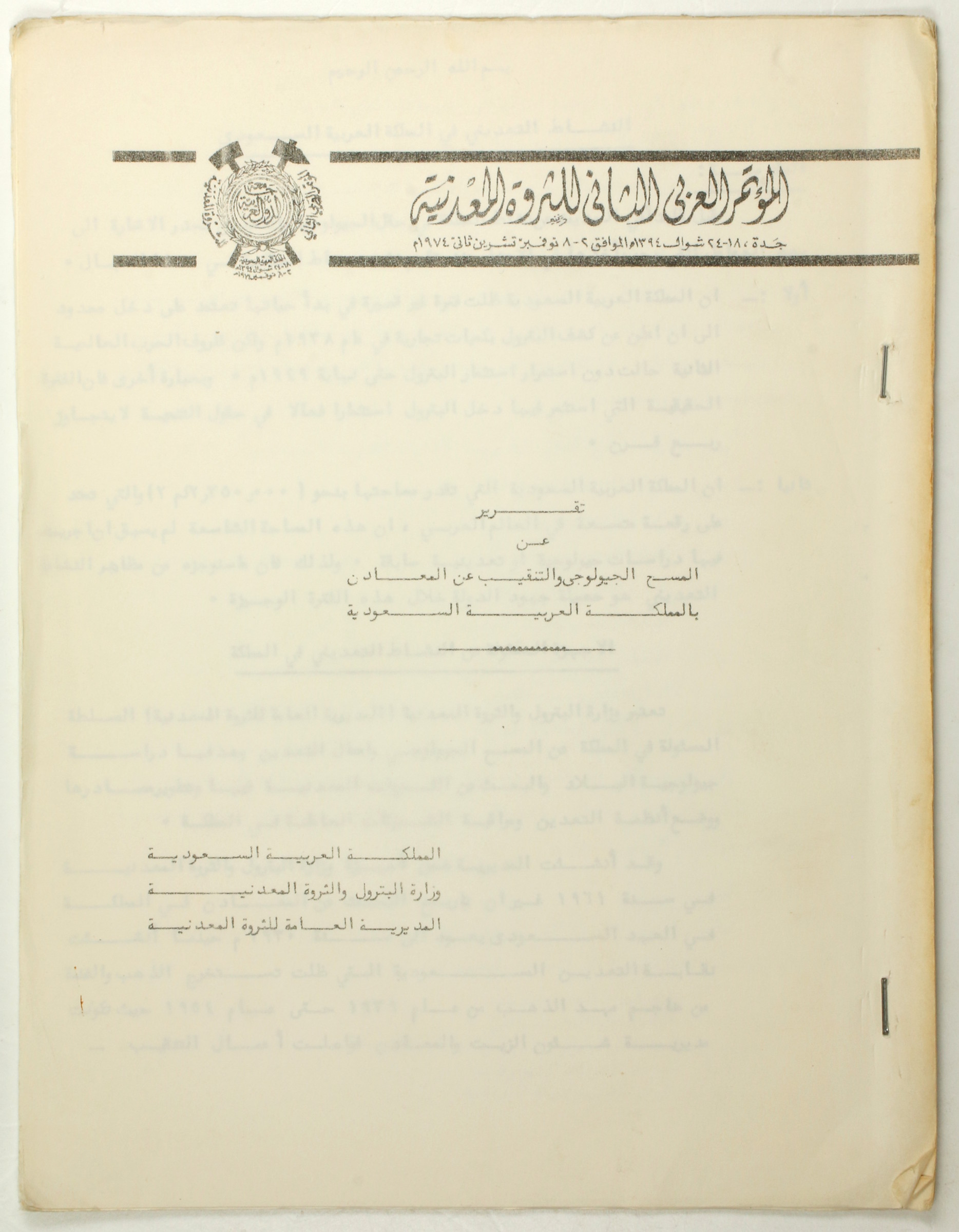
Rare governmental publication on mining activity in Saudi Arabia, presenting prospected geological survey projects. Mentions the milestone mapping programme of the 1950s and 1960s, producing the first geographico-geological maps of Saudi Arabia: the groundbreaking, fully bilingual and dual-dated series prepared by the U.S. Geological Survey and the Arabian American Oil Company under the joint sponsorship of Saudi Arabia and the U.S. State Department. Printed entirely in Arabic, including a chart on the inner lower wrapper illustrating the budget available for matters of mineral wealth.
Edges somewhat worn. Otherwise fine.

Permit of passage for Mahmoud Mohamed Mowafi, an employee of the Anglo-Egyptian Oil Wells Company, for business trips to the Red Sea Governorate, the Sidr and Assal regions, and the Sinai.
Valid through 1 April of 1958, not renewed thereafter.
Very well preserved.










